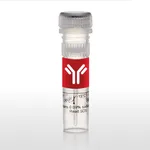Thermo Fisher Scientific KCNJ5 (Kir3.4) Polyclonal Antibody
다른 상품 둘러보기
Applications
Tested Dilution
Publications
Western Blot (WB)
1:200
Product Specifications
Species Reactivity
Human, Mouse, Rat
Host/Isotype
Rabbit / IgG
Class
Polyclonal
Type
Antibody
Immunogen
RNAMNQDMEIGVT(C), corresponding to amino acid residues 6-18 of rat Kir3.4, Intracellular, N-terminus if (typeof window.$mangular === undefined || !window.$mangular) { window.$mangular = {}; } $mangular.antigenJson = \[{targetFamily:Kir3.4 (KCNJ5),uniProtId:P48548-1,ncbiNodeId:10114,antigenRange:6-18,antigenLength:419,antigenImageFileName:APC-027-200UL_Kir3.4_KCNJ5_P48548-1_Rabbit.svg,antigenImageFileNamePDP:APC-027-200UL_Kir3.4_KCNJ5_P48548-1_Rabbit_PDP.jpeg,sortOrder:2}\]; $mangular.isB2BCMGT = false; $mangular.isEpitopesModalImageMultiSizeEnabled = true;
View immunogen .st0{fill:#FFFFFF;} .st1{fill:#1E8AE7;}
Conjugate
Unconjugated Unconjugated Unconjugated
Form
Lyophilized
Concentration
0.8 mg/mL
Purification
Antigen affinity chromatography
Storage buffer
PBS, pH 7.4, with 1% BSA
Contains
0.05% sodium azide
Storage conditions
-20° C, Avoid Freeze/Thaw Cycles
Shipping conditions
Ambient (domestic); Wet ice (international)
Product Specific Information
Reconstitution: 25 µL, 50 µL or 0.2 mL double distilled water (DDW), depending on the sample size. The antibody ships as a lyophilized powder at room temperature. Upon arrival, it should be stored at -20C. The reconstituted solution can be stored at 4C for up to 1 week. For longer periods, small aliquots should be stored at -20C. Avoid multiple freezing and thawing. Centrifuge all antibody preparations before use (10000 x g 5 min).
Target Information
G protein-coupled inwardly rectifying potassium channels (Kir3.1 through Kir3.4) are coupled to numerous neurotransmitter receptors in the brain and are abundantly expressed in the olfactory bulb, hippocampus, neocortex, dentate gyrus, cerebellar cortex and thalamus regions of the brain. Also known as GIRK, Kir3 potassium channels localize to the soma and dendrites as well as axons of neurons. Liberated Gbg subunits from G protein heterotrimers bind to and regulate Kir3 channel activity. Gb3- and Gb4-containing Gbg dimers bind directly to cytoplasmic domains of Kir3 proteins and increase the K+ current while Gb5-containing Gbg dimers inhibit Kir3 K+ current. Kir3 activity is also inhibited by tyrosine phosphorylation. Brain-derived neurotrophic factor activates receptor tyrosine kinase B, which then phosphorylates Kir3 tyrosine residues, effectively inactivating the Kir3 channels.
For Research Use Only. Not for use in diagnostic procedures. Not for resale without express authorization.
배송/결제/교환/반품 안내
배송 정보
| 기본 배송비 |
| 교환/반품 배송비 |
|
|---|---|---|---|
| 착불 배송비 |
| ||
| 교환/반품 배송비 |
| ||
결제 및 환불 안내
| 결제수단 |
|
|---|---|
| 취소 |
|
| 반품 |
|
| 환급 |
|
교환 및 반품 접수
| 교환 및 반품 접수 기한 |
|
|---|---|
| 교환 및 반품 접수가 가능한 경우 |
|
| 교환 및 반품 접수가 불가능한 경우 |
|
교환 및 반품 신청
| 교환 절차 |
|
|---|---|
| 반품 절차 |
|

